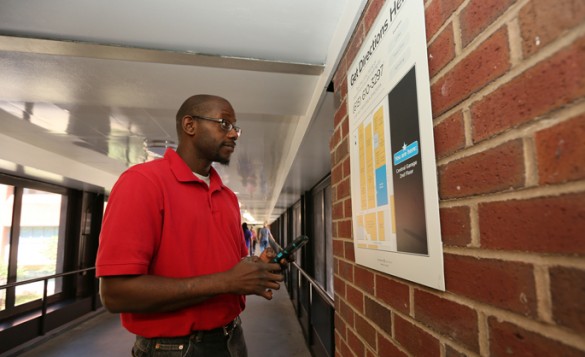Visitor Terry Manning uses his smartphone to test text-based directions to find Vanderbilt University Hospital’s Courtyard Café while he waits for his girlfriend during her appointment. (photo by Anne Rayner)
Getting to a patient’s room or finding the right clinic for an appointment can be stressful, but Vanderbilt University Medical Center (VUMC) leaders believe a mobile app, called WalkWays, as well as a texting tool that provide easily understood, visual directions will help everyone find their way.
“VUMC has more than 11.5 million square feet of space, so when those of us who work here have trouble finding our way, it is even more challenging for our patients and visitors to get to the right location, ” said Titus Daniels, M.D., MPH, MMHC, executive director of the Vanderbilt Medical Group (VMG) “We are always looking for ways to improve the experiences of patients and their families, and we believe this technology will help people get to where they want to be with greater ease.”
“Too often, each of us in the VUMC community sees patients and their family members standing in hallways throughout the Medical Center, clearly lost and struggling to find their way to a clinic appointment, to visit someone in the hospital, or even to find the cafeteria,” said Paul Sternberg Jr., M.D., Chief Patient Experience Officer for VUMC. “Fortunately, our staff will stop and assist these folks. However, having an effective tool to help our patients and families avoid experiencing that ‘lost’ sensation and to navigate our large and complex footprint more easily is critical to the enhancement of care.”
In 2014, then Nashville Mayor Karl Dean unveiled a “wayfinding app” at Music City Center, the city’s 1.2 million-square-foot convention center. The app uses low-energy Bluetooth signals from a user’s smartphone that interact with wall-mounted beacons. The app then sends photo-based, step-by-step directions to a requested location, such as the nearest restaurant, to the user’s phone.
VUMC leaders decided they wanted a similar system added to the Medical Center’s miles of hallways. They learned a Vanderbilt University faculty member, Jules White, Ph.D., assistant professor of computer science, was the brain behind the system’s technology. White had created a startup company, called ZH Solutions, through Vanderbilt’s Center for Technology Transfer to provide indoor positioning systems in large buildings, and he was thrilled to bring the technology to the Medical Center campus.
“For something the size and scope of Vanderbilt University Medical Center, it takes a lot of thought to ensure we’ve catalogued everything a patient would need to find, and in a way that’s going to be intuitive to the patient,” said White. “The installation of the technology itself was fairly easy. One thing that was challenging was to get good photos of places in the Medical Center that are very rarely empty.”
To develop a pilot of the WalkWays app, White worked with a VUMC team that included Daniels; Betsy Brandes, director of Digital and Design; Brian Carlson, director of Patient Access and Experience; and Dave Andrews, manager of Guest Services.
The team asked the Vanderbilt University Hospital Patient and Family Advisory Council and VUMC Guest Services employees to help them identify specific places patients and their families were frequently asking to find, as well as alternative names that might be used for those locations.
The main hospital, The Vanderbilt Clinic, the north and south towers of Medical Center East, the Medical Arts Building, patient areas of Medical Center North (such as the Round Wing), and the Vanderbilt-Ingram Cancer Center, as well as the entry landings for Central and East garages are included in the current app. A future expansion will include Monroe Carell Jr. Children’s Hospital at Vanderbilt and Vanderbilt Health One Hundred Oaks.
A few hundred users, including an online advisory committee called Advise Vanderbilt, tested the app. Feedback from these early users helped to further refine the tool, said Brandes.
Terry Manning of Columbia, Tennessee, brought his girlfriend to VUMC for a pre-surgery appointment in early 2016, and the pair became so lost in the hallways that they were a half-hour late. As he waited for her in the surgery waiting room in June, he was happy to learn about the new WalkWays app. He downloaded it to his smartphone and began trying it out.
“This app is awesome, and we could have used it to find that first appointment for sure,” he said. “I was pushing her in a wheelchair, and she was getting so frustrated. Younger folks, especially, will like having this because they can type in a question and get somewhere on their own.”
“We think this is a great addition to our patient experience to relieve some of the anxiety folks might experience,” said Dave Andrews, manager of VUMC Guest Services. “When visitors say to us that the Medical Center is too big, we say, ‘It is a large city, but we try to do all we can to make it feel like a small town.’”
If individuals don’t want to install the WalkWays app on their phones, there is also a text-based option to provide the same type of directions, Brandes said. Signs with specific phone numbers have been put up at main entry points to the Medical Center. Users can text the name of what they’re trying to find to the phone number on the sign in front of them to receive photo-based directions to get them to the location.
“There are patient families that may come to our Medical Center in the dark of night, so they don’t really have time to get acclimated to the facility,” said Andrews. “They might just need to find the nearest place to grab a cup of coffee. We want to make sure they can do that.”
You can download the free WalkWays app through the Apple app store for iPhones or through the Google Play store for Android phones.
Media Inquiries:
Jill Clendening, (615) 322-4747
jill.clendening@vanderbilt.edu
